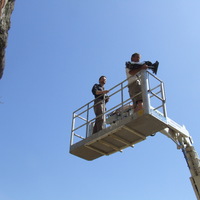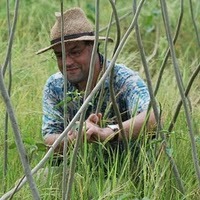Papers by Duncan Keenan-Jones

Journal of Roman Archaeology, 2016
HÉLÈNE DESSALES, LE PARTAGE DE L’EAU. FONTAINES ET DISTRIBUTION HYDRAULIQUE DANS L’HABITAT URBAIN... more HÉLÈNE DESSALES, LE PARTAGE DE L’EAU. FONTAINES ET DISTRIBUTION HYDRAULIQUE DANS L’HABITAT URBAIN DE L’ITALIE ROMAINE (Bibliothèque des Écoles françaises d’Athènes et de Rome, fascicule 351; École française de Rome 2013). Pp. xv + 602, figs. 191, pls. en couleur hors texte 7. ISBN 978-2-7283-0944-3. While interest in monumental public fountains1 has continued unabated in recent years,2 the subject of private fountains has been awaiting a treatment such as the one under review here. H. Dessales, however, somewhat hides her light under a bushel when she states (e.g., 12-13) that the purpose of her book is to investigate fountains alone, for it contains substantial treatments of every conceivable facet of Roman water supply and distribution, drawing upon copious literary sources and archaeological evidence. Moreover, while focused on Italy, the study makes considerable use of data from across the Roman world, particularly Spain, Gaul and N Africa, rendering it especially useful for the interpretation of sites throughout the Roman West. It is the best available treatment of urban water systems in the western empire, providing a more focused and comprehensive study than the second edition (2002) of the late A. T. Hodge’s Roman aqueducts and water supply,3 which had to cover the whole Roman world and in a briefer format. Any criticisms in what follows are not meant to detract from the value of this work, intending instead that this review function alongside the book as a means of assisting students of Roman water supply (and Roman archaeology more generally), for whom Le partage de l’eau will certainly become an important reference work.

Earth System Science Data, 2018
Stable isotope records from speleothems provide information on past climate changes, most particu... more Stable isotope records from speleothems provide information on past climate changes, most particularly information that can be used to reconstruct past changes in precipitation and atmospheric circulation. These records are increasingly being used to provide "out-of-sample" evaluations of isotope-enabled climate models. SISAL (Speleothem Isotope Synthesis and Analysis) is an international working group of the Past Global Changes (PAGES) project. The working group aims to provide a comprehensive compilation of speleothem isotope records for climate reconstruction and model evaluation. The SISAL database contains data for individual speleothems, grouped by cave system. Stable isotopes of oxygen and carbon (δ 18 O, δ 13 C) measurements are referenced by distance from the top or bottom of the speleothem. Additional tables provide information on dating, including information on the dates used to construct the original age model and sufficient information to assess the quality of each data set and to erect a standardized chronology across different speleothems. The metadata table provides location information, information on the full range of measurements carried out on each speleothem and information on the cave system that is relevant to the interpretation of the records, as well as citations for both publications and archived data. The compiled data are available at
Le Centre pour la Communication Scientifique Directe - HAL - SHS, Jan 26, 2017
Le Centre pour la Communication Scientifique Directe - HAL - SHS, Jan 28, 2016

Archaeology and Physical Anthropology in Oceania, Dec 1, 2022
Fish traps and fish weirs built by Indigenous people in the Barwon-Darling River system of the Mu... more Fish traps and fish weirs built by Indigenous people in the Barwon-Darling River system of the Murray Darling Basin (MDB), southeastern Australia, are an important component of their traditional social, spiritual and economic systems. The celebrated Brewarrina stone fish traps (Ngunnhu) on the Barwon River are the largest and best documented stone fish traps in the Basin. However, there has been minimal research on the many other stone fish traps in this system. This paper focusses on the in-stream stone fish traps downstream of Brewarrina along the Darling (Baaka) River, some still partly extant, remembered, or documented in historical material. Wooden and earthen bank fish traps and weirs, while not as enduring and archaeologically visible as stone fish traps, were frequently used on the Darling (Baaka) floodplain lakes, swamps and billabongs. Archaeological evidence, traditional cultural knowledge and historical materials are utilised to document the complex social processes and modification of landscapes associated with fish traps and weirs. By demonstrating that Barkandji were active and successful managers of the river and its ecology prior to colonisation, and that much of this cultural knowledge is retained by current generations, the authors make a case for them to renew their custodianship and a decision-making role in water management.
Cell Reports Physical Science
Geological Society of America, Oct 1, 2021
Climate of the Past Discussions, 2019

Travertine crystal growth ripples are used to reconstruct the early hydraulic history of the Anio... more Travertine crystal growth ripples are used to reconstruct the early hydraulic history of the Anio Novus aqueduct of ancient Rome. These crystalline morphologies deposited within the aqueduct channel record the hydraulic history of gravity-driven turbulent flow at the time of Roman operation. The wavelength, amplitude, and steepness of these travertine crystal growth ripples indicate that largescale sustained aqueduct flows scaled directly with the thickness of the aqueous viscous sublayer. Resulting critical shear Reynolds numbers are comparable with those reconstructed from heat/ mass transfer crystalline ripples formed in other natural and engineered environments. This includes sediment transport in rivers, lakes, and oceans, chemical precipitation and dissolution in caves, and melting and freezing in ice. Where flow depth and perimeter could be reconstructed from the distribution and stratigraphy of the travertine within the Anio Novus aqueduct, flow velocity and rate have been quantified by deriving roughness-flow relationships that are independent of water temperature. More generally, under conditions of near-constant water temperature and kinematic viscosity within the Anio Novus aqueduct channel, the travertine crystal growth ripple wavelengths increased with decreasing flow velocity, indicating that systematic changes took place in flow rate during travertine deposition. This study establishes that travertine crystal growth ripples such as those preserved in the Anio Novus provide a sensitive record of past hydraulic conditions, which can be similarly reconstructed from travertine deposited in other ancient water conveyance and storage systems around the world. A reliable supply of fresh drinking water, coupled with an effective water delivery management system, are two of the essential elements required to build and maintain human civilization. Fulfilment of these basic requirements has carried power and prestige in virtually every culture throughout human history 1. Where water has sufficiently high supersaturated concentrations of dissolved minerals (hard water), it precipitates deposits composed of calcium carbonate (CaCO 3) limestone called travertine 2,3 within water transport and storage systems. In the process, these travertine deposits preserve a record of the complexly intertwined physical, chemical, and biological processes that have influenced their deposition 2-5. Travertine deposited during the operation

Hero's treatise on building automata exploits ideas and terminology from machines used in... more Hero's treatise on building automata exploits ideas and terminology from machines used in Greco-Roman construction and other contexts. Hero's drive mechanism inverted the function and load-bearing capacity of cranes and the key element, the exeliktra (‘unwinder’), encapsulated that inversion. Bearings were crucial to the success of these and other mechanical devices, but their characteristics have been neglected. A range of bearings, including the knōdax, khoinikis and khelōnion, began to take shape in construction machinery in the sixth century BCE, and was later extended to areas such as artillery. Its terminology remained stable into the imperial period, notwithstanding (partial) translation into Latin. In his automata, Hero prefers the more specialised iron knōdax and suggests that friction was particularly influential in that choice. Hero is consistent and demonstrates mechanical expertise and experience in his design, but both his statements and his silences allow us to draw some inferences about his intended audience.

Water History, 2021
A short review is presented covering English-language publications where quantitative engineering... more A short review is presented covering English-language publications where quantitative engineering analysis has been used to study and gain insight into how ancient Roman and Mediterranean water systems functioned. The review covers work on using technical engineering perspectives to try and understand the geometrical layout of water systems, quantitative work of a type readily accomplished by undergraduate civil engineering students, such as calculating the flow capacity of aqueducts and other conduits of known dimensions, and more involved studies using computational techniques usually applied by specialist engineers in research or industry. It is concluded that the many different levels of analyses employed have given insight into how Roman water systems worked, for example the amount of water they delivered, and the kinds of issues their designers and operators might have faced. It is hoped that this review will inspire further interdisciplinary study in Archaeohydrology, using m...

Cliodynamics: The Journal of Quantitative History and Cultural Evolution, 2019
The historical turn in the social sciences has been neglected by historians. This has caused soci... more The historical turn in the social sciences has been neglected by historians. This has caused social scientists to use much data which has not been curated by experts focused on the relevant time periods and geographic locations. A recent article by Oka et al. investigating the important question of historical trends in violence is a good example. A detailed survey of Oka et al.'s Persian, Greek and Roman population, army size and casualty data reveals several problems. The uncertainty in ancient data, especially casualty figures, has been underappreciated by Oka et al. In population and army size data, some speculative and dependent data points have been treated as independent. There are also inconsistencies in the data and some inflated figures. The situation is worse for the ancient army size and casualty figures for individual battles used by Oka et al., which suffer from systematic biases designed to magnify the achievements of the historian's own culture. This is clearly illustrated by the main battles of Alexander the Great against the Persians, in which Alexander's forces, although greatly outnumbered, are supposed to have inflicted hundreds or thousands of times more casualties that they sustained. These issues demonstrate the importance of curation of such data by scholars focused on the relevant time periods and cultures, and we recommend that historians become actively involved in such research.

Proceedings of the National Academy of Sciences of the United States of America, Sep 28, 2017
Heavy metals from urban runoff preserved in sedimentary deposits record long-term economic and in... more Heavy metals from urban runoff preserved in sedimentary deposits record long-term economic and industrial development via the expansion and contraction of a city's infrastructure. Lead concentrations and isotopic compositions measured in the sediments of the harbor of Ostia-Rome's first harbor-show that lead pipes used in the water supply networks of Rome and Ostia were the only source of radiogenic Pb, which, in geologically young central Italy, is the hallmark of urban pollution. High-resolution geochemical, isotopic, and (14)C analyses of a sedimentary core from Ostia harbor have allowed us to date the commissioning of Rome's lead pipe water distribution system to around the second century BC, considerably later than Rome's first aqueduct built in the late fourth century BC. Even more significantly, the isotopic record of Pb pollution proves to be an unparalleled proxy for tracking the urban development of ancient Rome over more than a millennium, providing a semi...

Proceedings of the National Academy of Sciences, 2016
The influence of a sophisticated water distribution system on urban development in Roman times is... more The influence of a sophisticated water distribution system on urban development in Roman times is tested against the impact of Vesuvius volcanic activity, in particular the great eruption of AD 79, on all of the ancient cities of the Bay of Naples (Neapolis). Written accounts on urbanization outside of Rome are scarce and the archaeological record sketchy, especially during the tumultuous fifth and sixth centuries AD when Neapolis became the dominant city in the region. Here we show that isotopic ratios of lead measured on a well-dated sedimentary sequence from Neapolis’ harbor covering the first six centuries CE have recorded how the AD 79 eruption was followed by a complete overhaul of Neapolis’ water supply network. The Pb isotopic signatures of the sediments further reveal that the previously steady growth of Neapolis’ water distribution system ceased during the collapse of the fifth century AD, although vital repairs to this critical infrastructure were still carried out in the...

American Journal of Archaeology, 2015
The reconstruction of Pompeii's water-supply system is currently the focus of much debate. This d... more The reconstruction of Pompeii's water-supply system is currently the focus of much debate. This debate is fueled by complicated and growing archaeological evidence for the water system within the town as well as three different proposed configura tions of Pompeii's aqueduct. The new synthesis of archaeological evidence presented here reveals three successive phases of piped distribution. The first, Augustan phase was altered considerably in a second phase to keep it operating, albeit with reduced supply, in the town's last decades. At the time of the eruption of Somma-Vesuvius in 79 C.E., a wholly new, third phase was under construction. A new interpretation of the archaeological remains around Ponte Tirone shows that the water that supplied Pompeii's distribution system came from either the Aqua Augusta or Somma-Vesuvius, but probably not from the Abella aqueduct. In addition, there is evidence in Ponte Tirone for a minimum ground uplift of approximately 30 cm on the flanks of the volcano prior to the eruption and greater deflation afterward. This uplift reduced and then stopped water supply to towns around the Bay of Naples, but whether it affected Pompeii remains unclear. This analysis further develops a new method of reconstructing past vertical ground movements via their impact on shallow-gradient, gravity-powered water systems.* in t r o d u c t io n : t h e c u r r e n t d e b a t e o v e r t h e s o u r c e a n d e n d o f p o m p e ii's w a t e rd is t r ib u t io n sy st e m Two lo n g-ru n n in g deb ates reg a rd in g P o m p eii's a q u e d u c t a n d lead-pipe distribution system co n c ern (1) th e w ater system 's source, a n d (2) its e n d. In particular, scholars disagree a b o u t th e source an d d ate o f th e first aqu ed u ctsup p lied w ater d istrib u ted th ro u g h o u t th e city, as well as th e status o f th e w ater system in th e last two decad es betw een th e 62-6 4 C.E. ea rth q u a k e s* 1 a n d th e 79 C.E. eru p tio n o f Somma-Vesuvius.2 T h e th re e d iffe ren t sources p ro p o sed fo r th e system are discussed below. M ost scholars have a rg u e d fo r an A ugustan d ate fo r th e aq u ed u ct-su p p lied system, b u t som e scholars have posited th a t S am nite o r Sullan colonial systems p re c e d e d th e A ugustan o n e .3
Papers of the British School at Rome, 2012

The Ancient Mediterranean Environment between Science and History, 2013
This chapter considers two case studies, both involving inter-basin transfers of water, in order ... more This chapter considers two case studies, both involving inter-basin transfers of water, in order to investigate elite Roman attitudes towards the use of water resources, particularly their attitudes towards deleterious consequences of such use on other communities and the wider environment. Before turning to the case studies, the chapter considers how hydrological cycle has changed in Central-Southern Italy since antiquity so that we can make use of modern data, and also the usage and legal control of water in rural areas. The chapter seems that the Roman elite around the turn of the era was prepared to consider, and to execute, plans involving large-scale alteration to the hydrologic landscape in order to benefit coastal urban centres and to serve imperial aims. Thus the history of water management in Central-Southern Italy shows the persistent influence of Roman technical achievements and thought right through to the early 20th century. Keywords:central-southern Italy; climate change; flood history; hydrologic landscape; Roman elite; water management

Papers of the British School at Rome, 2010
collaboration with the British School at Rome's Sainsbury Scholars, Celia Hempton and Katie C... more collaboration with the British School at Rome's Sainsbury Scholars, Celia Hempton and Katie Cuddon, I devised an exhibition and performance of tableaux vivants in the School's Gallery, inspired by the historical context of the era in which the mural was discovered. 'Second Style: an Odyssey Frieze' acknowledged and engaged with the environment into which the Odyssey Frieze was reborn, in an attempt to see the painting anew. My Ralegh Radford Rome Scholarship began during the final months before I submitted my Cambridge Ph.D. thesis, Vitruvius and the Rhetoric of Display: Wall Painting, Domestic Architecture and Roman Self-fashioning. This thesis interpreted Vitruvius's De Architectura (c. 20s BCE) as a literary response to the first-century Roman social environment. Its focus was Vitruvius's authorial self-fashioning and his commentary on domestic architecture. In conducting this research, I looked beyond the stylistic differences that set De Architectura apart from canonical works of Roman poetry and prose. Comparative analysis with authors such as Catullus, Horace and Cicero uncovered a variety of textual parallels that shed light on the treatise's apparent contradictions, factual inaccuracies and other peculiarities. While acknowledging the value of a spate of very recent publications that analyse De Architectura within a specifically Augustan context, my thesis demonstrated that many of Vitruvius's views had ample precedent in the literature of the late Republic. Vitruvius and the Rhetoric of Display, therefore, ultimately supported an argument for continuity, despite political change, in the Roman literature and social life of the first century BCE. I benefited greatly from the opportunity to complete this project using the library resources of the British School at Rome and surrounding academies. I also presented my findings at a meeting of the Associazione Internazionale di Archeologia Classica that took place at the School, as well as at the 2009 Workshop on Ancient Greek and Roman Scientific, Medical and Technical Writing at Newnham College, Cambridge.











Uploads
Papers by Duncan Keenan-Jones